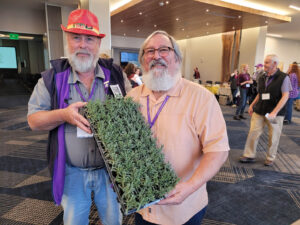
USA Lavender farming
By Clive Larkman
As a plant for ornamental and medicinal use, lavender has a history as long as European settlement. Even with this history, there has been very little research and understanding of how to farm this tough little plant. There are numerous thoughts that the plant needs neither food nor water making it an interesting plant for the lazy farmer or those in poor countries with little rainfall.
I recently attended the United States Lavender Growers Association annual conference. As an industry, they are much larger than ours but about the same by comparative population. They have a strong and active membership but are experiencing similar issues to the Australian industry. They have 800 members and the average farm size is 1.5 acres which means they are a cottage industry, and the majority of their lavender is used for value-added products at the farm gate.
The topic of my talk was “Lavender Biology – Understanding and using it to your advantage”. This may seem a bit obvious but many farmers and growers fail to understand the evolutionary biology of their crop. Lavender is an easy plant to grow, will yield well under most conditions and is tolerant of many harsh climatic conditions, hence growers have spent little time understanding what it is that determines how lavender plants behave.
Over the years I have often discussed the various environmental factors that will limit or promote how a plant grows and what it yields. It is only through understanding these that we can maximise yield from minimal input. As mentioned above, many people feel that you can grow lavender without additional water or fertiliser. This is correct; in most parts of temperate Australia you can grow lavender with no more water than natural rainfall, and the vast majority of soils will provide enough nutrients for the plants to grow well and yield adequate quantities of oil that have an acceptable makeup of constituent oils.
Yes, you can grow lavender with nil inputs but this is survival farming, not commercial production. After I delivered my presentation, I was swamped with questions that were basically: ‘What, you fertilise lavender?’ The belief in the US was that not only does lavender need minimal water and fertiliser but that plants will go backwards if extra is added. Many growers were from traditional farming backgrounds and the concept of nil fertilising made little sense to start with, although some of the industry’s early leaders were strong in the belief that lavender should never be fertilised.
Although this belief or advice wasn’t good, the fact that these farmers didn’t trust their instincts is disappointing. Also, no-one seemed to be thinking for themselves which is my biggest frustration with all aspects of agriculture, from broadacre farming to intense niche horticulture. One could say that this is the real problem with modern society – people are more easily convinced by an article they read on Facebook than to think for themselves and trust years of learning and experience.
Overall it was a great conference. It is good to attend conferences in our home states but it’s also beneficial to attend them in other countries. Sometimes it can be eye-opening to see how other communities approach the same issues we do. One thing Americans do well is take up new concepts, especially if they help the bottom line. After my talk, and discussion with many of the farmers, I feel they will be very quick to start fertilising their plants and maybe even start research though their agricultural extension programs.
Every state has at least one research program, in at least one of their tertiary institutes. Both the American people and their governments see the value of publicly-funded research in all aspects of agriculture. It is almost a disgrace that here in Australia we have shut down our equivalents in all states. I would be interested to see how we compare with other developed countries in the amount of resources we contribute to research that is 100% publicly funded. Most of our research has to be part-funded by industry which makes it very hard for small and non-structured or levied industries to obtain the work needed to become larger industries.
Main photo: Clive Larkman (left) with Lloyd Traven from Peace Tree Farm, Pennsylvania. (Image: Clive Larkman)
